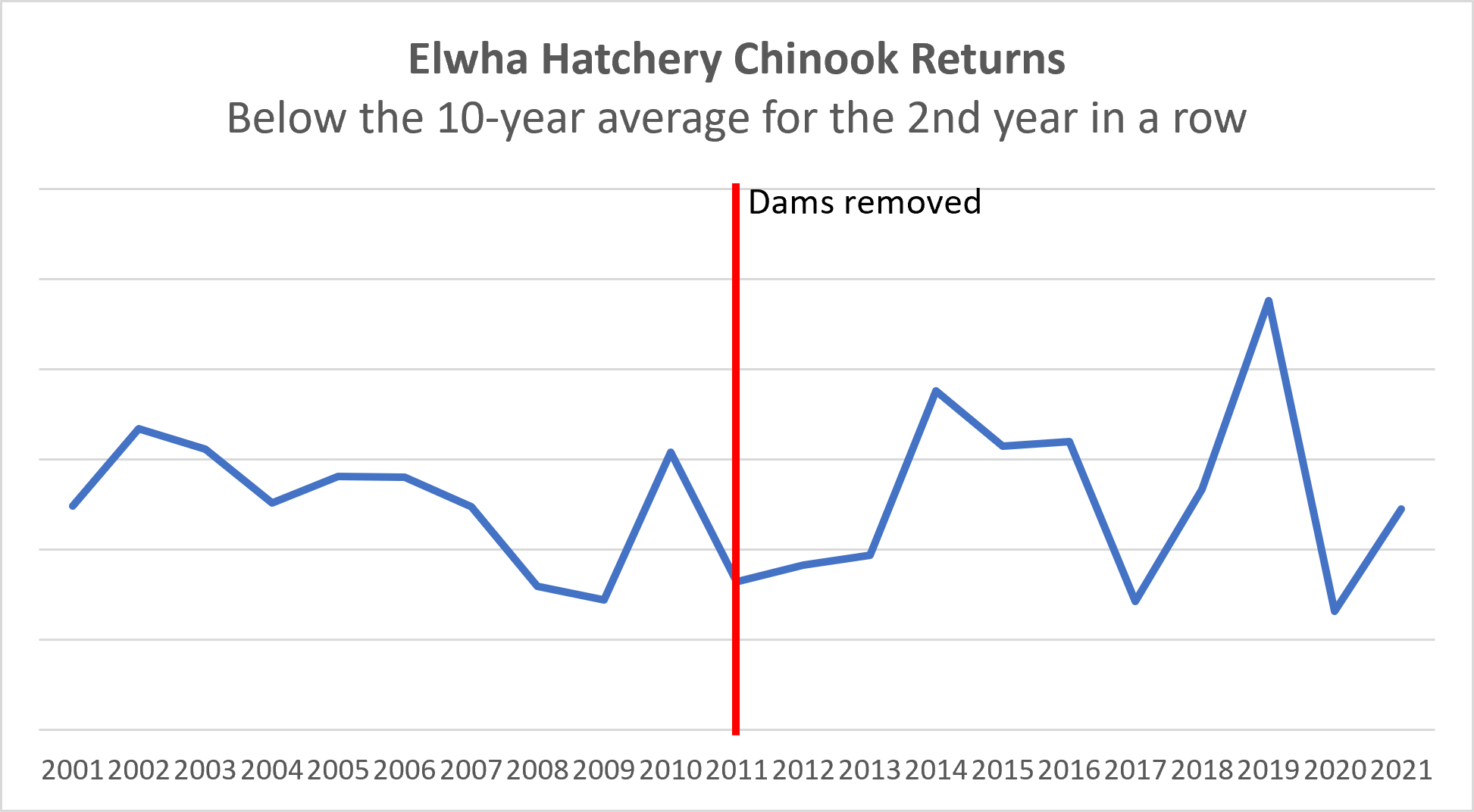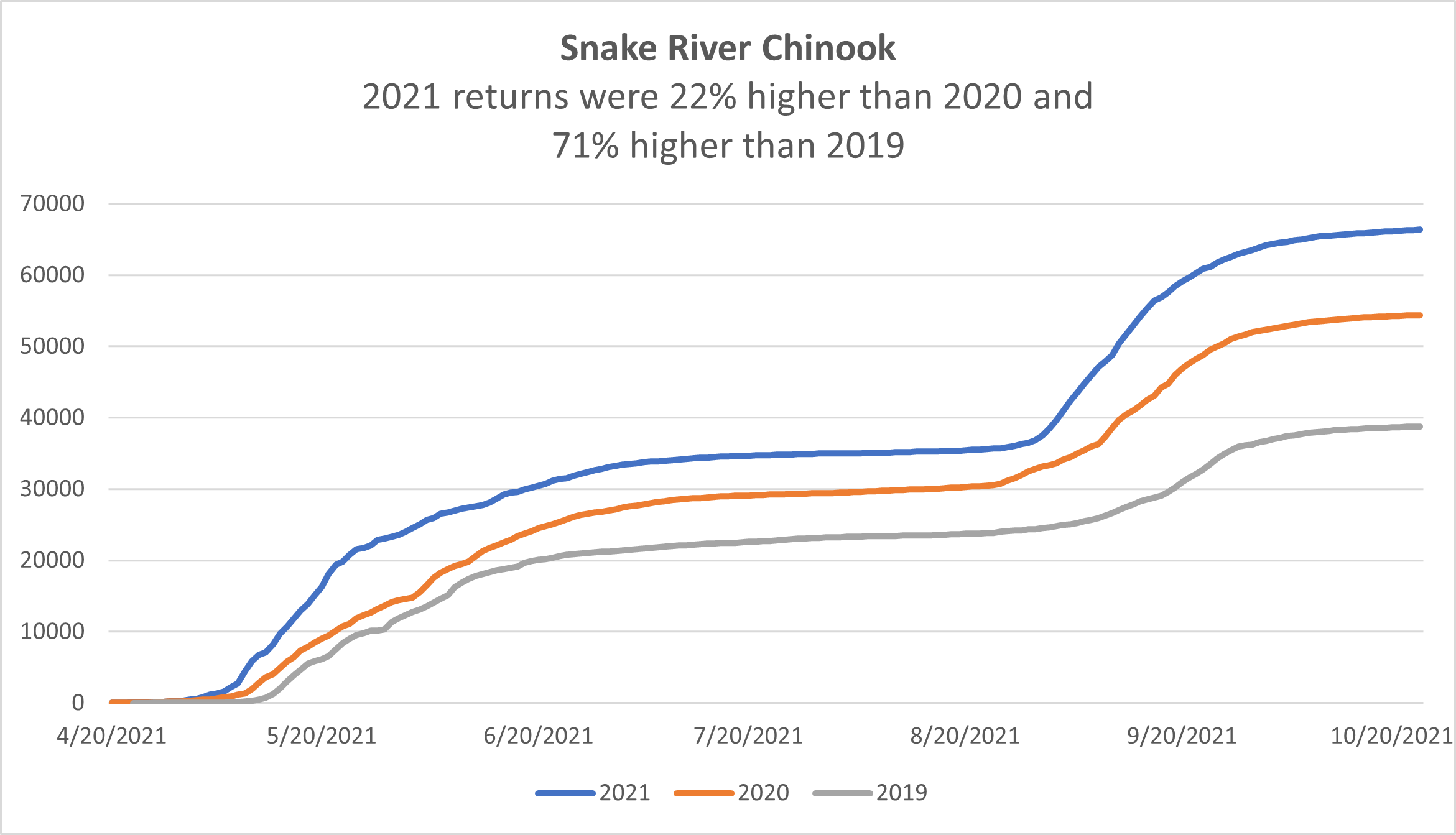Update below
As October draws to a close, the salmon runs in Washington state have largely concluded. Not unusually, the numbers are mixed. With so much focus on dam removal, as opposed to the more mundane but important work of wider habitat restoration, it seems appropriate to look at the runs of threatened Chinook salmon in the Elwha River and the Snake River.
If you listened to some politicians and environmental activists, you would think the Chinook returns in the Snake River are collapsing while returns on the Elwha River are “surging back.”
The data tell the exact opposite story. Here’s a look at the 2021 results.
Elwha River Chinook: below average
The removal of the two dams on the Elwha River has been the touchstone for activists calling for the destruction of other dams around the state. Activists like Lynda Mapes have repeatedly claimed success. Mapes, who wrote a book about removing the  dams, claimed last year that, “the Elwha represents one of the only watersheds in Puget Sound with such an uptick in population.”
dams, claimed last year that, “the Elwha represents one of the only watersheds in Puget Sound with such an uptick in population.”
The data show that the one-year uptick in 2019 was ephemeral and 2021 returns were again below average for the 10 years before the dams were removed and the decade since.
Through October 28, the total hatchery escapement is 1,227. Recent reports from the Washington State Department of Fish and Wildlife show about 95 percent of returning Chinook are hatchery fish.
It may take more for salmon runs to recover. That hasn’t stopped activists like American Rivers from claiming, “The story of the Elwha is: We can do it. We can overcome a century of harm. We can work together. We can restore a river.” The actual data tell a different story.
Snake River Chinook: continued recovery
At the other end of the spectrum is the Lower Snake River, where the governor recently claimed salmon runs are “near extinction” and environmental groups claim Spring/Summer Chinook on the river will be functionally extinct by 2025. Again, the data  contradict those claims.
contradict those claims.
Overall, Snake River Chinook runs were 22 percent higher than 2020 and 71 percent higher than 2019. These increases are part of a cycle of Snake River Chinook and are not unexpected after the nadir of returns in 2019.
The 2021 returns are still slightly below the 10-year average of the 2010s, but it is the second year in a row returns have increased. They contradict the claim that returns would decline this year.
Additionally, projections for 2022 show a big increase in the Spring/Summer Chinook run on the Lower Snake River.
I have offered a $50 bet to activists claiming the Spring/Summer Chinook run will be smaller next year. So far, only one person accepted the bet, although he reduced it to $5. Fair enough. At least he was willing to put something on the line.
Scott Levy, an anti-dam activist sent an email saying, “I’ll wager $5000. Are you in? Your donation will be payable to bluefish.org.” Initially I declined because even with a high level of confidence, I don’t have money to throw around. However, I have since accepted the bet and sent two emails accepting the bet. I have not heard back, however, and he now appears to be backing away.
Update:
After publication of this blog, Scott emailed, "yes I am willing to make the donation to Habitat for Humanity if the Spring/Summer runs come in higher next year." So, we have a bet. A little more high stakes than I intended, but it is for a good cause.
As I have explained before, betting is a tax on overconfidence and is a way of holding activists accountable for dramatic but inaccurate proclamations. It doesn’t surprise me that people would prefer to continue making inaccurate claims without risk of paying the price.
There is, however, a price for spreading dishonest and inaccurate information. It is paid by salmon, families, workers, and the environment as politicians are lured by false data to waste time and resources on projects that don’t help increase salmon populations.





